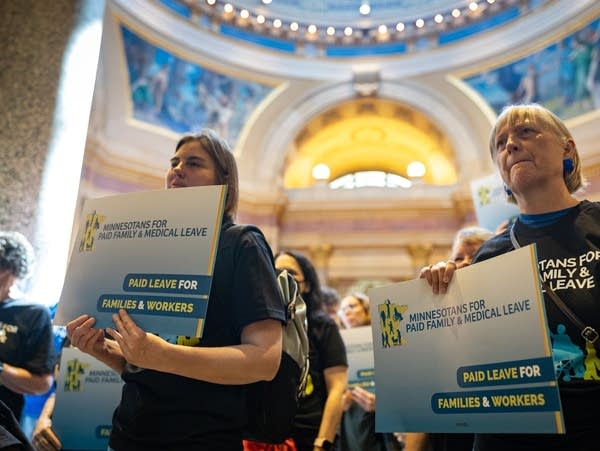Almost all Minnesota workers may get paid time off for family and medical leave

Go Deeper.
Create an account or log in to save stories.
Like this?
Thanks for liking this story! We have added it to a list of your favorite stories.
Paid family and medical leave is poised to become law in Minnesota.
Most working Americans have access to unpaid time off for the arrival of a child or to handle their own or a family member’s illness. But three in four American civilian workers have no access to paid family leave and one in five has no access to paid sick leave.
Under a proposal working its way through the final legislative stages, paid leave would expand to nearly all working Minnesotans.
Listen to the conversation where MPR News guest host Chris Farrell speaks with MPR News senior politics reporter Dana Ferguson about the paid family and medical leave, how it would work and what the next steps are.
Turn Up Your Support
MPR News helps you turn down the noise and build shared understanding. Turn up your support for this public resource and keep trusted journalism accessible to all.
“A conference committee approved a report over the weekend that incorporates pieces of the House and Senate bills and that agreement has to be passed again in both chambers. If and when that happens, the bill will go to the governor who has said he will sign it into law. But I should be clear, Chris, it's likely the legislature would come back next year and into the future to make some tweaks and changes to the program as it's put in place,” Ferguson said during the show.

Farrell also was joined by John Reynolds, Minnesota state director for the National Federation of Independent Businesses. The organization represents small businesses in Minnesota.
He talked about the concerns he hears from business owners, how the program would impact their operations and why he thinks a voluntary program would be better than a state-run program.
“If people wanted to pull together and purchase family and medical leave insurance, or just medical leave insurance, or however you want to take care of it, that would be a much better option. Because for one thing, I think that the payroll tax will end up being much higher because no other state has tried a leave length and a wage replacement level of this magnitude,” Reynolds said.
“Also, not all workers are looking for the same thing. That's another thing I hear over and over from our small business members. Some workers want more vacation, some workers want a 401(k) match, some want a higher percentage of their medical premium paid and there's not an infinite pool of money for labor costs. That's just the reality,” he added.
Rep. Ruth Richardson (DFL-Mendota Heights), the chief sponsor of HF2, the House version of the paid family and medical leave bill, also joined the conversation. She talked about the benefits of the bill, such as “premium relief” which means that the smallest businesses won’t have to pay toward the premium for the program.
“The system that we currently have right now is all about luck and whether someone is lucky enough to work with an employer that provides access to paid family medical leave. And what we know with the current system that we have, the individuals who are most likely to be left out of the program are women, people of color, and low income workers,” Richardson said.
“I would just lift up the fact that this bill is a collection of many different voices, including small businesses, large businesses, the insurance industry, the faith community, nonprofits,” she added.
We also talked with small business owners all across Minnesota who both support and oppose the program. They shared their experiences and how the paid family and medical leave would impact their businesses.

Subscribe to the MPR News with Angela Davis podcast on: Apple Podcasts, Google Podcasts, Spotify or RSS.
Use the audio player above to listen to the full conversation.


